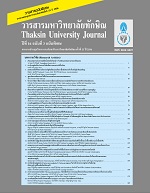เปอร์เซ็นต์การปฏิสนธิและเปอร์เซ็นต์การฟักของไข่ปลาดุกลาพันจากการผสมเทียมโดยใช้น้าเชื้อสด น้าเชื้อแช่เย็นและน้าเชื้อแช่แข็ง
Main Article Content
Abstract
ความสำเร็จในการเก็บรักษาน้ำเชื้อปลามีความสำคัญสำหรับการอนุรักษ์พันธุกรรมและการเพาะเลี้ยงสัตว์น้ำ การศึกษาครั้งนี้จึงเปรียบเทียบเปอร์เซ็นต์การปฏิสนธิและเปอร์เซ็นต์การฟัก ของไข่ปลาดุกลำพันจากการผสมเทียมโดย ใช้น้ำเชื้อสด น้ำเชื้อแช่เย็นและน้ำเชื้อแช่แข็ง ผลการศึกษาพบว่าการผสมเทียมปลาดุกลำพันโดยใช้น้ำเชื้อแช่เย็นมี เปอร์เซ็นต์การปฏิสนธิเท่ากับ 81.8±5.1 % ซึ่งมีค่าต่ำกว่าเปอร์เซ็นต์การปฏิสนธิของน้ำเชื้อสด (97.5±0.4%) และน้ำเชื้อ แช่แข็ง (91.5±4.1 %) อย่างมีนัยสำคัญทางสถิติ (P< 0.05) และพบว่าไข่ที่ผสมเทียมด้วยน้ำเชื้อแช่เย็นและน้ำเชื้อแช่แข็งมี เปอร์เซ็นต์การฟักไม่แตกต่างกัน โดยมีค่าเท่ากับ 52.4±11.2 และ 47.1 ± 14.2 % ตามลำดับ แต่มีค่าต่ำกว่าไข่ที่ผสมเทียม ด้วยน้ำเชื้อสด (75.5±4.1%) อย่างมีนัยสำคัญทางสถิติ (P< 0.05) ผลการทดลองดังกล่าวแสดงให้เห็นว่าการใช้น้ำเชื้อแช่เย็นและน้ำเชื้อแช่แข็งประสบความสำเร็จในการผสมเทียมปลาดุกลำพัน แต่มีประสิทธิภาพต่ำกว่าน้ำเชื้อสด ข้อมูลดังกล่าวเป็นประโยชน์ต่อการเก็บรักษาน้ำเชื้อเพื่อการผลิตลูกพันธุ์หรือเพื่อการอนุรักษ์
Fertilization and Hatching Percentage of Slender Walking Catfish (Clarias nieuhofu) Eggs Artificially Inseminated with Fresh, Chilled and Cryopreserved Sperm
Jamjum Pechsiri1*, Adcharat Suwanpugdee2 and Suphada Kiriratnikom1
1 Aquacultural Biotechnology Research Unit, Faculty of Science, Thaksin University, Pa-Phayom, Phattalung 93110
2 Faculty of Technology and Community Development, Thaksin University, Pa-Phayom, Phattalung 93110
Successful preservation of fish spermatozoa provided important implications for genomic conservation and for aquaculture. The present paper assessed the fertilization and hatching percentage of slender walking catfish eggs fertilized with fresh, chilled or cryopreserved sperm. The result showed that there was no significant difference (P>0.05) in the percentage of fertilization between fresh and cryopreserved sperm, but the percentage of fertilization using chilled sperm (81.8±5.1 %) was significantly lower (P<0.05) than using fresh (97.5±0.4%) and cryopreserved sperm (91.5±4.1 %). Mean hatching percentage of egg artificially inseminated with chilled and cryopreserved sperm were 52.4±11.2 and 47.1 ± 14.2 %, respectively. They were significantly lower (P<0.05) than using fresh sperm (75.5±4.1%). The results of this study indicated that chilled and cryopreserved sperm can be used for artificial breeding in Clarias nieuhofii, but had lower efficiency than fresh sperm. This provides important information for making decision to preserve sperm for seed production and/or conservation purposes.


